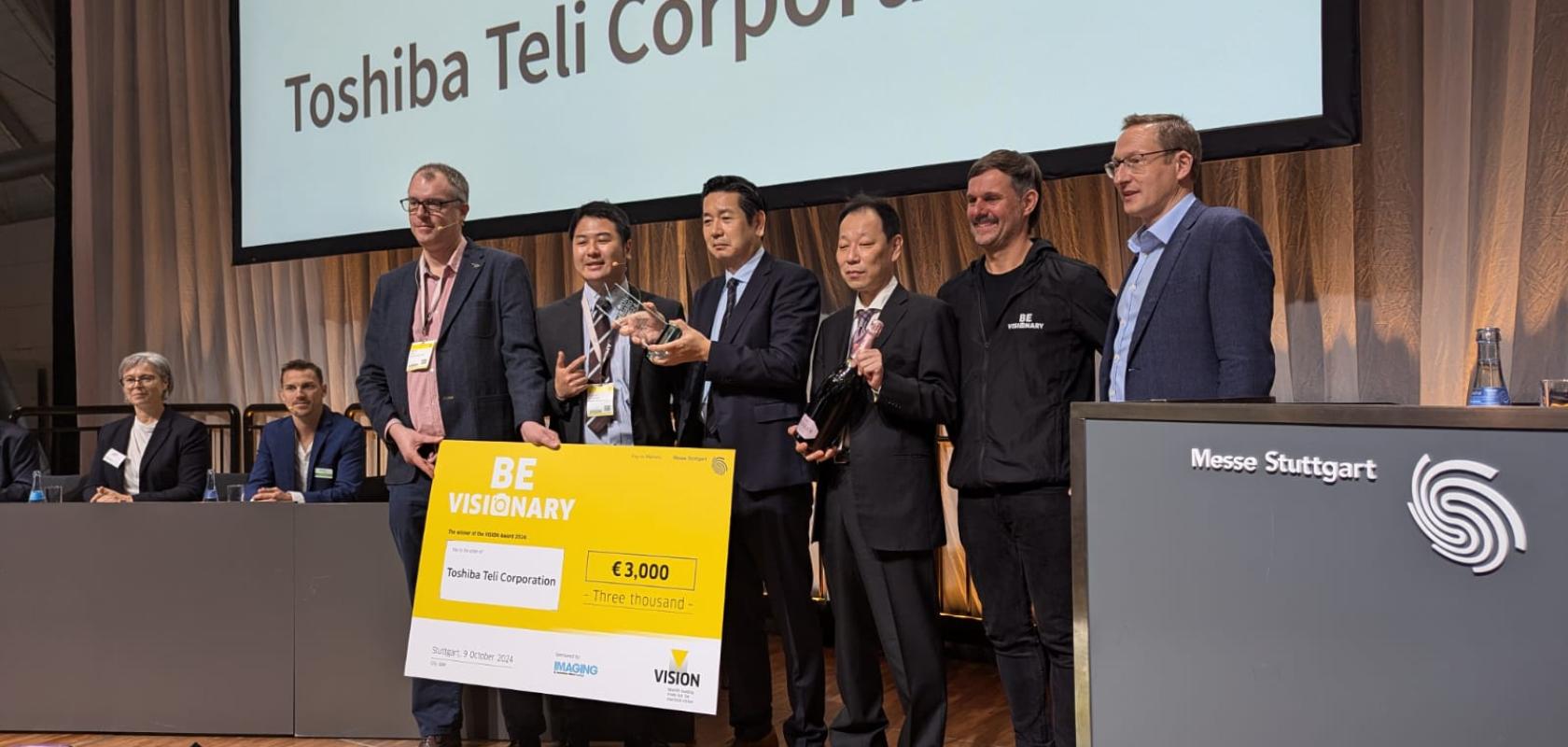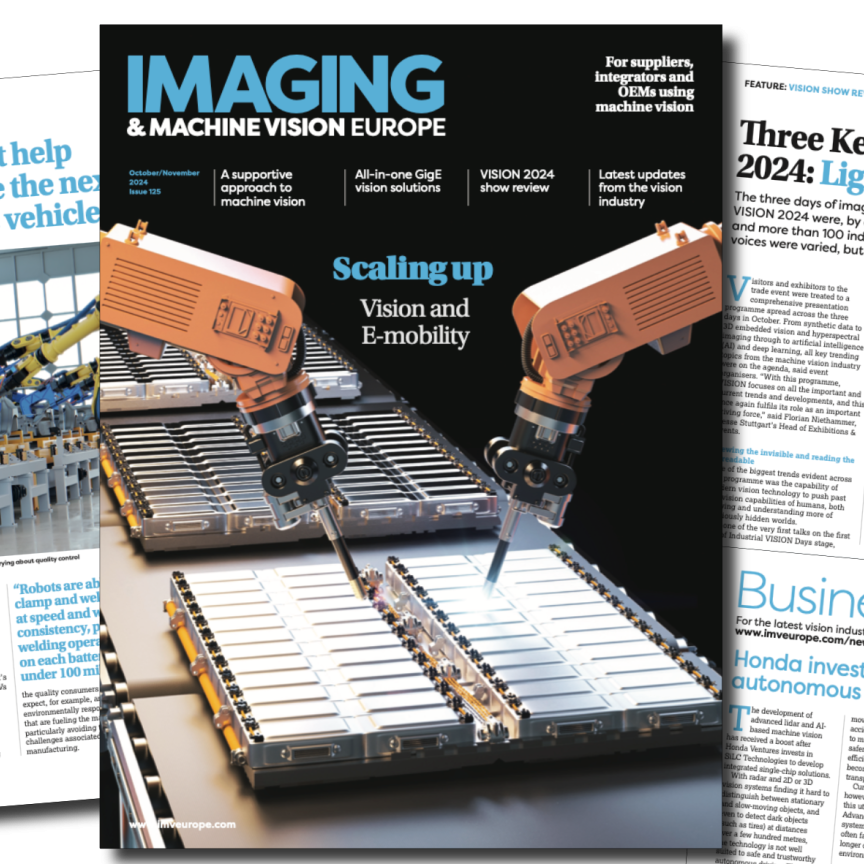The winner of the 2024 VISION Award at Messe Stuttgart has just been selected, from a shortlist of five nominees including AiRob Vision Systems, AIT Austrian Institute of Technology, Murrelektronik, PxE Holographic Imaging and Toshiba Teli Corporation.
Honouring the best innovation from the field of machine vision over the past two years, the VISION Award is one of the most anticipated parts of the three-day VISION event. Along with the €3,000 prize money - sponsored by Imaging & Machine Vision Europe - the winning company also gets to take home the recognition of being VISION Award winners, and the associated “opportunity to address a wider trade audience,” said Corey Merchant, VP Americas of Kitov.ai - VISION Award winners last time out in 2022.
“Winning the VISION Award allows us to continue the development of this technology,” said Merchant, “making it easier for manufacturers to introduce automated visual inspection,” after his company were announced as the 22nd winner of the Award in 2022. Part of the VISION trade show since 1996, previous winners also include Prophesee’s Metavision® Technology, an event-based sensing and software solution (2021); Machine Vision Lighting’s VISA-Method Lighting (Variable Irradiation Solid Angle) solution, transforming conventional lighting wisdom in machine vision (2016); and AIT Austrian Institute of Technology’s real-time stereo vision technology for an intraoral 3D scanner (2011) to name a few.
After whittling down 60 entrants to a shortlist of just five. The nominees were asked to present their innovations to the VISION 2024 crowd at the Industrial VISION Days stage.
2024 VISION Award nominees:
AiRob Vision Systems
AiRob’s Vision Systems’ VIS Expert system provides integrated quality assurance for THT (Through-Hole Technology) component assembly - both improving the quality and reducing the costs of PCBA (printed circuit board assembly) production. The VIS Expert system “leverages cutting-edge vision technology supported by AI within a unified ecosystem,” said AiRob Vision Systems’ CEO Dariusz Hebisz, introducing the technology onstage.
AIT Austrian Institute of Technology
As previous winners, the AIT Austrian Institute of Technology has been here before, of course, but that doesn’t mean its ici:microscopy solution for 100% inline combined 2D/3D microscopy - featuring the ability to quickly and accurately reconstruct 3D models at high resolution and speed - has any less a chance of taking the grand prize.
AIT’s solution offers the precise inspection of small-scale objects’ finer details, utilising parallax effects and obtaining high scanning speeds up to 12mm/s, alongside depth resolution of 2.8μm. The solution “combines light field with photometric in a single smart camera sensor,“ explained Petra Thunner, in her nominee’s presentation.
Murrelektronik
Murrelektronik introduced the amassed audience at VISION 2024 to its Xelity Hybrid Switch technology - a local power and data hub for the trigger signals of a vision system, allowing designers to avoid complex long-range connections with hefty control cabinets. “Say ‘bye-bye’ to the control cabinet,” said Murrelektronik’s Simon Knapp, who described how users could “daisy-chain” multiple devices to “extend the application, step by step.”
PxE Holographic Imaging
PxE Holographic Imaging introduced the HoloCoder - which combines hardware and software which use a standard CMOS image sensor and standard camera ISP to produce a white light hologram - to the VISION Award jury. The innovation is able to “capture colour, depth and other data that traditional CMOS sensors that only measure intensity cannot,” said Yoav Berlatzky, speaking to Imaging & Machine Vision Europe before the event.
Toshiba Teli Corporation
Rounding off the shortlisted nominees, Toshiba Teli Corporation’s Yusuke Kawachi introduced the company’s surface flaw detection scope - an appearance inspection device that utilises “OneShotBRDF(TM) technology to detect object defects such as scratches, with an optical system that distinguishes them with colour. The application is also suited to detect variances in texture in similarly visible objects, such as between rough and glossy finished white paper, as Kawachi evidenced.
And the winner is…
After the five nominees had each described their innovations to the crowd, the winner was announced as Toshiba Teli Corporation, with its Surface Flaw Detection Scope technology. With groundbreaking, multi-sector technology applications across machine vision, the Surface Flaw Detection Scope offers significant advantages over traditional inspection methods, detecting minute scratches with high-speed inspection and capturing a wide area in a single shot to enhance the efficiency of inspection processes.
"The jury was impressed by the new technical approach for detecting very fine scratches and irregularities, especially on glassy or highly polished surfaces," said Dr. Chris Yates from Vision Ventures, who was on the jury and presented the Award. "A large number of products nowadays have such surfaces, often with extremely high demands on their quality." The winning entry provides a "solution which is simple enough to be used by lay persons, but sensitive enough to detect flaws measuring a few millionths of a metre."
Another element of Toshiba Teli's entry the jury pointed towards, was that it can increase the visibility of hard-to-detect material flaws without needing any software processing. "This feature shows the technology can be implemented in production systems or inline systems," providing an immediate picture of all flaws, said Yates.
Accepting the award, Shinichi Itokawa, Chief Technology Executive, Director of Machine Vision Camera and board member of Toshiba Teli Corporation, said: "I am very honoured to receive the prestigious VISION Award. The motivation for developing the SFD (Surface Flow Detection) Scope came from the various inspection consultations we received from our customers. There were many cases where even scratches that could be identified by the eyes of skilled technicians could not be detected by conventional machine vision systems."


